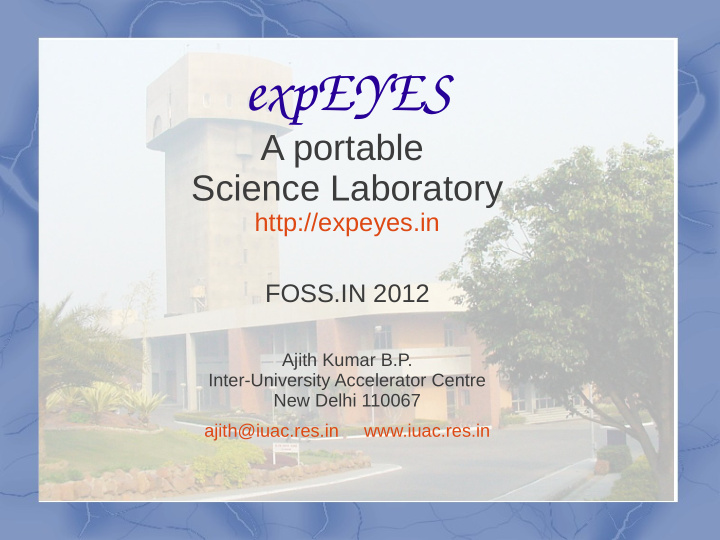



expEYES A portable Science Laboratory http://expeyes.in FOSS.IN 2012 Ajith Kumar B.P. Inter-University Accelerator Centre New Delhi 110067 ajith@iuac.res.in www.iuac.res.in
Result of a highly thought provoking and motivating lecture...
Our Science/Engineering Education THEORY Experiment .. and it goes in circles.
Why Experiments are ignored in our Science Education ? ● Exam oriented evaluation system. ● Lack of interest. ● Lack of equipment. The PHOENIX project, started by IUAC in 2005, tries to address the third issue, by designing cost-effective science/engineering experiments.
What is expEYES ? A low cost device that can generate/measure voltages as a function of time and generate graphs. A tool for learning by exploring. Supports Science & Engineering experiments from High School to Post Graduate level. A test equipment for electronics hobbyists. All with Open Software & Hardware
ExpEYES on a netbook, studying a PN junction Diode
Features: ● 12 bit Analog Input/Output ● Digital I/O ● Time interval measurements ● Waveform Generation ● USB Powered ● GUI for 50 experiments ● Python Programmable ● Works as a Test Equipment ● 8.6 x 5.8 x 1.5 cm 3 , 60 gm. ● Open Hardware
GUI programs available for around 50 experiments Example 1: Four channel CRO (250 ksps)
Study of Logic Gates A B O AND Gate OR Gate
Interference of Sound MIC Buzzers
Transistor Characteristics
Acceleration due to Gravity, by Time of Flight import expeyes.eyesj p= expeyes.eyesj.open() p.set_state(10,1) raw_input('Ready') print p.clr2rtime(10,0) Electromagnet releases a metal ball and the loudspeaker generates a signal when it touches ground.
And many more … http://expeyes.in
Design of expEYES Junior Real-time measurement features of Micro-controller + Computational and Graphics capability of Python . import expeyes.eyesj p = expeyes.eyesj.open() from pylab import * t,v = p.capture(1, 200, 100) plot(t,v) show()
Reducing total cost: cheaper computers. ARM processor based Netbook Netbooks with Atom processor. around 7000/- from Wishtel Costs around 13000/-
Tested on Raspberry Pi and Aakash2 By Aakash2 team, IIT, Bombay Combined with Aakash2, total cost of setting up a lab is around Rs. 3000/-
What is expEYES for Students : An affordable tool for doing experiments, anytime anywhere. Freedom from the lab timings. Teachers : A tool for doing demos, experiments and to develop new experiments. Engineers : An open system that combines basic physics, electronics, micro-controller programming, computer interfacing, GUI programming and scientific computation. Hobbyist : A nice tool to kill more time with less money.
The PHOENIX project was started in 2005, with the objective of developing cost effective experiments for teaching science. 2005 : Parallel port device, 2006: micro-controller version RS232 / USB options. Linux / DOS Python code C code
2011: expEYES 2012: expEYES Junior ● USB Powered ● USB Powered (70 mA@5V) ● 12 bit ADC/DAC ● 12 bit ADC/DAC ● 11x9x1.5 cm, 150 gm ● 8.6x5.8x1.6 cm, 60 gm. ● Rs. 3000/- ● Rs. 1600/-
The reptile creeps in.. (from C to Python) http://pramode.net) Value of 'g' from Time of Flight, (using electromagnet, ball & speaker) from phoenix import * p = Phoenix() p.write_motors(0xf) # Energize the coil t = p.get_drop_time() # Drop the ball and time it! print t
Status of PHOENIX Project ● More than 1000 units are in circulation. ● Included in the syllabus in some Universities. ● Trained around 300 physics teachers. ● Conducted around 35 awareness programs at different places. Every year IUAC conducts two “Six days training programs on PHOENIX”
Phoenix at Lycée Jean Bart, France Georges Khaznadar, Science teacher & Debian developer. Volunteers for PHOENIX Project 22
Project Objective Make high quality laboratory equipment available to every science student, by making it affordable. US$ 30 US$ 2.0 Both contains almost same amount of hardware. Mass production makes the cost difference. 23
Role of Python in Science & Engineering Education Science/ Applied Engineering Mathematics Python Mathematical Analysis of Modelling / Experimental Simulations Data Experimental Experimental Data Acquisition & Data Acquisition & Control Control
Data Analysis & Visualisation (AC mains pickup signal) from pylab import * import expeyes.eyesj, expeyes.eyemath as em p=expeyes.eyesj.open() t,v = p.capture(1,1000, 100) vf, par = em.fit_sine(t,v) plot(t,v) plot(t,vf) print par[1]*1000 show() 50.1209437171
Simulations: The mass & spring problem from visual import * wall = box (pos=(0,0,0), length=0.1, height=2, width=4, color=color.white) ball = sphere (pos=(4,0,0), radius=1, color=color.red) spring = helix(pos=(0,0,0), axis=(4,0,0), radius=0.5, color=color.red) t = 0.0 dt = 0.01 x = 2.0 v = 0.0 K = 100.0 # Spring constant M = 1.0 # Mass attached while 1: rate(20) f = -k * x # Equation to solve v += (f/m ) * dt x = x + v * dt t = t + dt spring.length = 4 + x ball.x = x + 4
Attempts to include Python in the Syllabus ● West Bengal State University ● MSc Physics ● IISER, Kolkata ● MS courses ● University of Calicut, Kerala ● BSc Mathematics ● BSc & MSc Physics (there may be more) It would help if more institutions do it.
Python book and Code Browser Python book under GNU FDL Download from http://expeyes.in/python-programming
For details visit http://expeyes.in
8 + 1 sources, More are welcome Open Hardware: Schematics & PCB files are on the website Software Distribution: ● LiveCD ● Debian Packages (part of Debian & Ubuntu repositories) ● Python Source files (for Windows etc.)
Many of the Control/Sensor elements are made from components used in consumer electronics. Rs. 1600/- Interface + Standard Accessory Set + LiveCD
Other commercially available equipment providing similar facilities. Pasco Vernier Proprietary products (closed source), not affordable to developing countries.
Thank You
More recommend